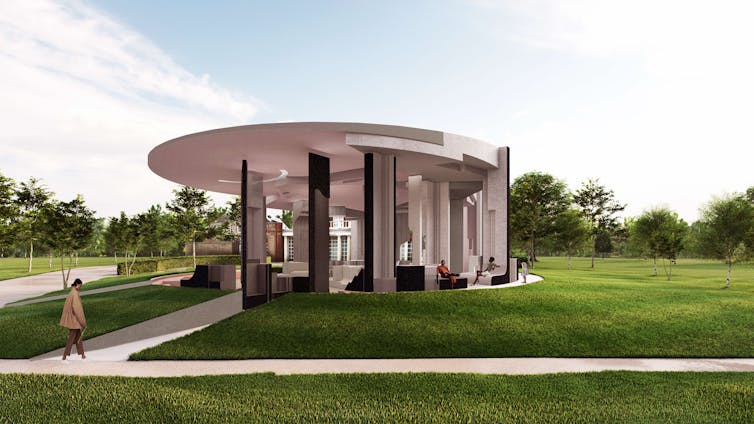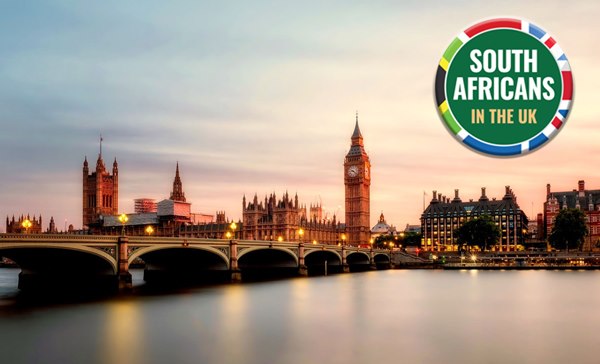Matthew Barac, London Metropolitan University
The arrival in London of a new Serpentine Pavilion is a design diary highlight every year.
Each commission sees a new temporary garden building – a pavilion – created by a selected international architect. It is organised by the Serpentine Galleries in Kensington Gardens, Hyde Park, regularly attracting over 1.2 million visitors a year.
In 2020 the prestigious Serpentine Pavilion was awarded to South African studio Counterspace. Soon afterwards, the organisers decided to delay and extend the commission over two years because of the COVID-19 pandemic. Now, finally, it is about to emerge into public life.
News of the choice of Counterspace was greeted with enthusiasm. The three women who set up the interdisciplinary Johannesburg practice are the youngest architects to land the Pavilion commission in its 20-year history. Past designers include architectural superstars such as Frank Gehry, Daniel Libeskind and Peter Zumthor.
The Serpentine Pavilion, a free-to-access destination and venue for cultural gatherings, has been seen as a vehicle for innovation. But detractors argue it has become a platform to celebrate “starchitects” and host paparazzi-friendly parties.
Recent attempts to diversify the message by selecting “up and coming” designers have met with mixed reviews, but the choice of Counterspace ups the ante. Here’s why.
Diverse alternatives
The pavilion is designed by Sumayya Vally, the Counterspace director. She is not the first female appointee. Celebrated British-Iraqi architect Zaha Hadid designed the inaugural pavilion, and women followed in 2009, 2015 and 2018. But Counterspace represents a new, forward-looking and timely attitude to inclusion, diversity and creativity.
Responding to the news, Lesley Lokko, African Futures Institute director and RIBA Annie Spink Award laureate, said:
As the world grapples with issues of race, identity and inequity in the built environment, this is an opportunity for a young African practice to show that the imagination is the most powerful tool for change.
Named for its belief that “every space has an equal and opposite counter-space”, Counterspace operates as a collaborative studio in which a culture of questioning is fundamental.
Who is Counterspace?
Founding principal Vally and her partners Sarah de Villiers and Amina Kaskar established the firm in their twenties. They want to change architectural knowledge just as much as they want to make buildings. All three teach while practising professionally.

Projects in the Counterspace portfolio include performances, installations, choreography and curating, as well as research investigations and building designs. Works include Folded Skies, a large-scale mirror sculpture in Cape Town, and the Brixton Mosque in Johannesburg, a scheme to wrap an existing church reused as a mosque in a new envelope that speaks the architectural language of Islamic geometry.
By contrast with the object-oriented architecture of most pavilions to date, Counterspace emphasises process. It wants to steer and gather the Serpentine Pavilion into being over time.
Time and the city
The act of building will extend beyond the opening date, spreading across the summer months. So the pavilion you see in June may change by the time you return for a second look in September.
This aligns with the Serpentine Gallery’s view too. According to artistic director Hans Ulrich Obrist, the silver lining of the pandemic is an “opportunity to take more time”. A range of events and research activities have been initiated, reframing the official opening date as a milestone on the Pavilion’s journey, rather than its destination.
Eminent architect David Adjaye counselled the pavilion’s trustees to
Accept the slowness reshaping society today and utilise it to develop a deeper relationship with the architects.
The Counterspace ethos will allow the pavilion to accommodate difference, even conflict. Vally, the only architect on the 2021 Time100 Next list, recently told me of her aspiration to deliver a space meaningful to Londoners near and far. It should reach out to those at the periphery, and reach in to the city centre.
The pavilion
A lofty circular roof defines the extent of the pavilion. It is both cosmological – a canopy of stars – and childlike in its symbolism of centrality, reminding us of the circle of play we make by joining hands.
Rising columns and wall fragments echo other histories, borrowing bits of the city and bringing them together in a bricolage of recombined and recycled fragments. Connections to other buildings, moments and places across London are suggested.
Sumayya Vally in conversation with Hans Ulrich Obrist 19.5.20 from Serpentine Galleries on Vimeo.
This architecture of visual quotations recalls the postmodern theories of Robert Venturi and Denise Scott Brown. The approach superimposes memories represented by design motifs. A cut and paste detail from a Notting Hill Caribbean café that was a hub for anti-racist activists in the 1960s might appear on the pavilion alongside an element drawn from the South London offices of the West Indian Gazette, a major Black newspaper founded by activist Claudia Jones in 1958.
This accumulation of elements and influences is filtered through Vally’s artistic processes of interpretation:
Any work that I do is about how I am shaped by the people that I work with, about ingesting as much as I can from a place and its people and then translating that into form.
Architecture of invitation
To date, the Serpentine Pavilion has provided a passive setting for people to meet. But Counterspace aims to actively engage with communities and sites of marginalised history across London – to draw people in.
This is an architecture of invitation. The design does not attempt to deliver insights but rather foster understanding, absorbing conflict by providing a context for bringing differences together.
It captures something of an emergent creative spirit – influenced but not defined by wokeness and related cultural controversies – in which the space to be flawed and unsure, to be real, is claimed as a stage for belonging.
This approach, which resonates with Robert McCarter’s reformulation of “place-making as resistance”, reminds us of the need to reclaim our capacity for human relationships. The pavilion invites us to rediscover public life and meet again, after our long confinement, in a space made for us and with us.
The 2021 Serpentine Pavilion opens on 11 June in London
This article was updated on 8 June 2021 to reflect that Vally was now the lead designer on the project.
Matthew Barac, Reader in Architecture, London Metropolitan University
This article is republished from The Conversation under a Creative Commons license. Read the original article.



